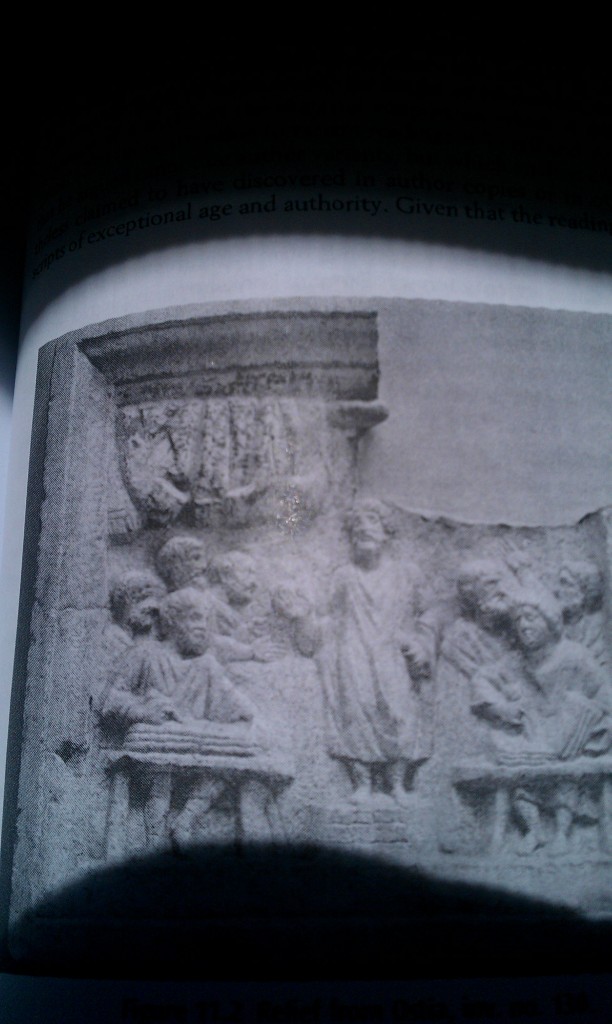Take a good look at this stone pediment. What do you see? This was found in Ostia, Italy, and it would originally have been founded on the front facing of a building. What sort of building— you ask? A bookshop, the store of a ‘librarius’
What you have depicted in this stone shop sign is a man speaking on a podium with two persons taking dictation on either side of him in codex form documents. Behind and to the left are listeners. What is being advertized in this display is a public performance or declamation, perhaps to sell scrolls/ books, perhaps by an author, or a famous rhetor who did public performances of the speeches of Cicero or Demosthenes, or even recitations of Vergil’s Aeneid in Latin. Think of a modern visit to Barnes and Nobles to hear an author read a bit of his latest work. What happened at an ancient, compared to a modern performance? Peter White describes it as follows (p. 282 in ‘Ancient Literacies’):
“At a recitation,a single person reads [or recites from memory] while others listen, having no textual material to orient or distract them. The reader’s script is not only unfamiliar to most of the audience, it is not yet publicly available; as a rule it is not yet a finished book. The reader [or reciter] occupies a physically distinct space from everybody else, a platform or open area that marks him as a performer. Yet in his performance, unlike an actor’s or an orator’s the written text serves as a crucial prop or accompaniment. The audience does not gather casually but has been recruited by invitation, and predominantly from members of the capital elite….The reciter’s performance is not normally interrupted except by applause nor is it followed by critical discussion.”
What White is actually describing is more of a private recitation in a home, than what is depicted on the shop sign, though, it is true enough that the people who frequented book shops in Rome and elsewhere were not merely the literate, but those who could afford the expense of buying scrolls or codexes. To draw an analogy— today while many people might well admire and look at books from the Folio Society, not many Americans are, or could be, collectors of such books. They are prohibitively expense.
Back to those copiers in the picture. White is clear enough that there was considerable evidence of stenography, or tachiography during the Empire, the ability to write either in short hand or very quickly or both, such that one could produce a virtual verbatim of a speech of a Cicero, or a Paul, or a Seneca. Quintilian laments how such stenographers would quickly transcribe his speeches in the late first century A.D. for profit, without his permission, and also without his corrections either (Inst. Or. 7.2.24).
Of what relevance is this to NT study? Much in every regard. In the first place, it was slaves who did most of the ancient copying, slaves employed in homes and shops and in government and in the army. Literate slaves, slaves with a good hand writing, slaves nicked in the wars that led to Rome dominating the Mediterranean, slaves from well educated, and even elite families. They were ubiquitous, they were for sale, and most business men in the Empire had at least one of them. Slaves, educated the elite’s children, slaves kept property records, slaves wrote letters, slaves made copies of great literary works (Homer, Plato, Aristotle, Vergil etc.). The reason I mention this is because it makes perfectly clear that literacy was not just a property of the elites of Roman society. Indeed, it was a necessary pre-requisite for slaves who would be recorders, scribes, grammatoi, clerks, employees of bookshop owners, etc. The growth of the Empire led to the spread of necessary literacy, because all sorts of documents and records needed to be made for religious, political, and commercial, as well as personal purposes. It is a mistake to under-estimate the necessity of literacy to be successful in even commerce during and before the Empire.
Consider the case of the remarkable Jewish woman Babatha, whose business records were found in the Cave of Letters at Qumran by the Dead Sea, dating to the early second century A.D.. The Hellenistic wave of culture had already swept through the area, and with it the rise of literacy, in particular knowledge of Greek and Greek culture. Babatha’s 35 extant documents were written in Greek, Aramaic, Nabatean, or a mixture thereof, with some necessary Latin loan words. What we find is documents for the sale of land, dates, wine, numerous marriage contracts, dowry documents, a court summons, a ledger of deposits and loans, depositions, an extract from the minutes of the council of Petra relating to the guardianship of her son, and so on (see the discussion by Greg Wolf, pp. 49-50). Babatha was neither royalty nor a ruler, but a formidable business woman apparently. While she was not an average person, it is a mistake to assume that she, a more well to do person, was responsible for composing all these documents. More likely she had a clerk, a scribe, a slave or slaves to do it. It is a mistake to underestimate how widespread certain kinds of literacies were in the ancient Greek and Roman world, including up and down the social scale. It all the more a mistake when it comes to Jewish society, where the concern for reading and learning a sacred text, whether in Hebrew or the LXX was a staple part of any child’s education, particularly male children. In our last post on the book Ancient Literacies, we will draw attention to some other of the major insights from this valuable book.













